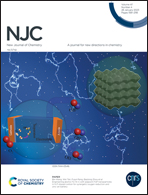Three-dimensional hierarchical flower-like bimetallic–organic materials in situ grown on carbon cloth and doped with sulfur as an air cathode in a microbial fuel cell†
Abstract
By developing the oxygen reduction reaction (ORR) of a high-activity catalyst suitable for an air-cathode microbial fuel cell (MFC), the generation capacity can be greatly improved. In this study, Zn/Co-S-3DHFLM, as a cost-effective cathode catalyst, is grown in situ on carbon cloth (CC). The ORR catalyst activity is greatly enhanced by the synergistic effect of the bimetallic active center and doping with non-metallic elemental sulfur. The flower-like Zn/Co-S-3DHFLM containing a large number of mesoporous structures is attached to the CC without an electrode binder, and it is used to assemble a double-chamber MFC cathode. The experimental results show that the newly assembled dual-chamber MFC could reach a high open circuit potential (OCP) of 629 mV and has a most excellent power density of 172.80 mW m−2, which is 13.27 and 2.56 times higher than that of Co-3DHFLM and Zn/Co-3DHFLM, respectively. The highest values are obtained for chemical oxygen demand (COD) removal of 93.0 ± 1.7% and Coulombic efficiency (CE) of 12.5 ± 0.9%. In addition, the Zn/Co-S-3DHFLM catalyst has excellent stability and methanol tolerance.



 Please wait while we load your content...
Please wait while we load your content...